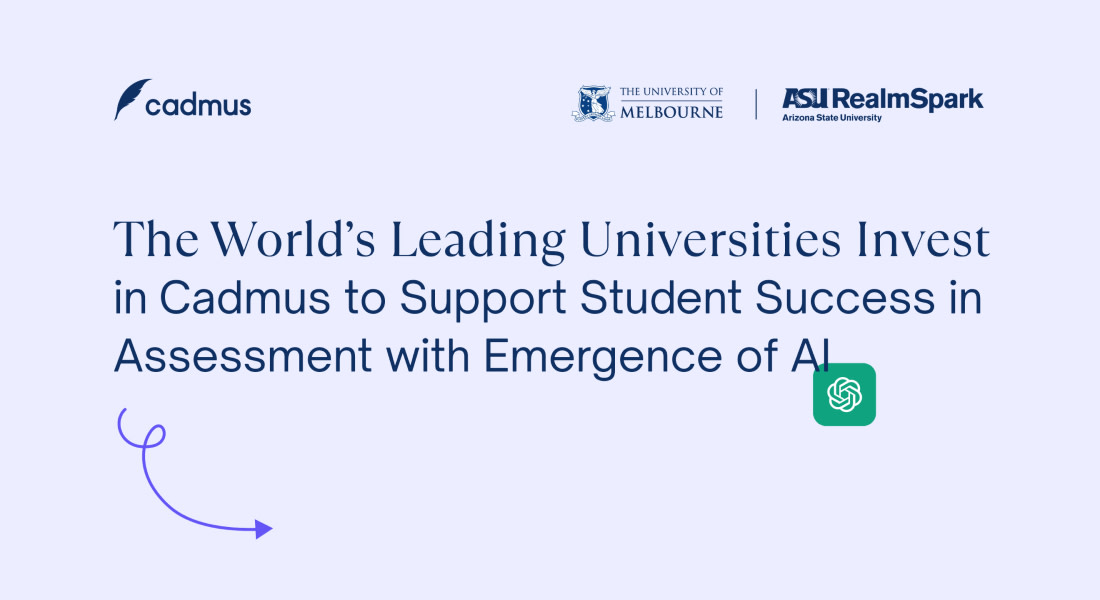4 ways Cadmus can save time and stress for large student cohorts

The challenges faced by foundational subjects across large and diverse cohorts of over 500 students are only increasing during the pandemic.
In 2021, two of these subjects at Charles Sturt University introduced Cadmus and found it to be a valued tool in both improving student wellbeing and also reducing time and stress for academic teams and markers.
Cadmus is an end-to-end assessment for learning platform, designed to support both academics and students through the entire assessment process. It provides value and support to students regardless of how they are learning: in-semester assignments, class activity, or summative tasks.
For teachers, it offers insights into how students are progressing, along with detailed academic integrity insights with a simplified workflow.
We look at the following examples of large cohorts who shared their experience at the Charles Sturt University EdX conference in December last year:
NRS160 Contexts of Learning (Sem 1 - 1089 students, Sem 2 - 540 students)
IKC100 Indigenous Health (531 students)
IKC101 Indigenous Culture, History and Contemporary Realities (535 students)
Here are some of the benefits of using Cadmus that they found effective in large cohorts.
1. Flexibility and accessibility
For Associate Lecturer in the School of Indigenous Australian Studies at Charles Sturt University Jessica Russ-Smith and Associate Head of School and Lecturer in Indigenous Australian Studies Kirsten Locke, it was essential that Cadmus supported the Indigenous standpoint pedagogical framework which IKC101 and IKC100 use and are guided by.
“During the pandemic, additional and complicated challenges are present for both teachers and students within our school. As guided by the Indigenous standpoint pedagogy we have a passion and a commitment to ensure our learning spaces are accessible for our students,” Associate Lecturer Russ-Smith explained.
Cadmus provided them with flexibility in due dates, including offering adjustments to extension due dates and tracking student progress to offer support.
One of the other benefits was the ability to offer resubmissions through the platform, where students were easily able to access and see the feedback to assist with their revisions.
Lecturer in Nursing Deborah Magee also looked at Cadmus first from a student engagement perspective, referencing Kahu and Nelson 2017, stating that the alignment of student and institutional factors is the catalyst for strong engagement.
“Cadmus assists positively with emotions and wellbeing of students; helping to manage time and workload, reduce stress, reduce anxiety and also to develop processes to complete assessment tasks which they can use in other subjects as they proceed through the Bachelor of Nursing.” — Deborah Magee
2. Education and onboarding
The Cadmus Team and NRS160 worked closely together after student feedback from first semester and a satisfaction rating of just over 70%. What came out of it was a program that had 95% of students reporting a positive experience in Semester 2.
The main change that Deborah Magee made following the Semester 1 feedback was to improve student onboarding to the platform. Cadmus Learning Support attended the first lecture to run through an introductory activity in Cadmus and talk through expectations.
Working with the Cadmus team, Ms Magee then made use of a formative, easy-to-complete task which was set up similarly to how they would use the platform through the semester.
It was a scaffolded tour of the platform including how to access notes, resources, and how to make submissions with the main goal to to reduce fear of a new tool and increase engagement with the first assessment.
3. Clear Communication
In NRS160, another learning outcome from Semester 1 was to improve communication and recognise the diversity in students' technological capabilities.
“We talk about digital natives as a main user of universities but certainly in such a large and diverse cohort it really is just an idea, and we are finding students entering tertiary education with poor computer literacy,” Magee said.
In Semester 2, Magee and her team worked to create clear messaging, ensuring the requirements in the rubric matched the capabilities of Cadmus.
It meant students did not need to worry about formatting, with zero ambiguity around instructions for summative tasks.
4. Benefits for marking teams: time and skills
Associate lecturer Russ-Smith referenced the example below in explaining how Cadmus helped her marking team over the course of the semester, saying the time saved was extrapolated for a larger cohort.
“In my first six months at CSU, using Cadmus was fantastic,” Russ-Smith said. “One of the reasons is that Cadmus allows teachers and the marking team to work in this one space.”
In both subjects Cadmus was able to simplify the marking process by marking submissions directly in Turnitin Feedback Studio through the class list, as well as allowing filtering of student papers by graded/ungraded. Each marker's papers could be allocated quickly in the same platform rather than downloading and manually dispersing each paper.

Russ-Smith said it also assisted with transparency in moderation, using Cadmus to scan marks, but also allowing her to see how individuals were marking in realtime so she could provide support and give feedback. For the markers, being able to see each others’ work was hugely beneficial for skill development.
Support for teachers and students alike
Cadmus was able to support large and diverse cohorts through student support and improved metrics on wellbeing and stress levels. For teachers, in addition to providing a central portal for student communications, it enabled a faster and more streamlined marking process with additional benefits for the markers.
“One of the great benefits of Cadmus is actually the Cadmus support team. Their constant support and quick responses are something that is really helpful — especially when we are getting used to a new system,” Russ-Smith said.
Both schools reported extremely positive experiences using the platform with satisfaction rates of over 85% and student responses showing it helped with taking the anxiety away from assessment administration.

Jess Ashman
Head of Learning
Keep learning…
The latest in teaching and learning. Delivered to your inbox.



